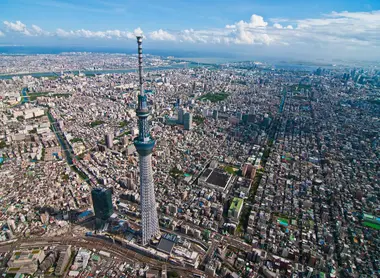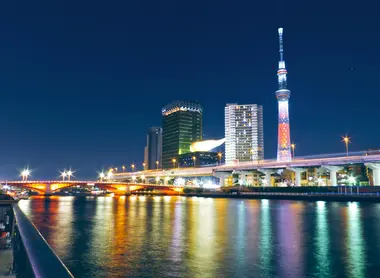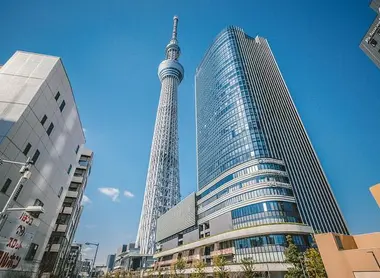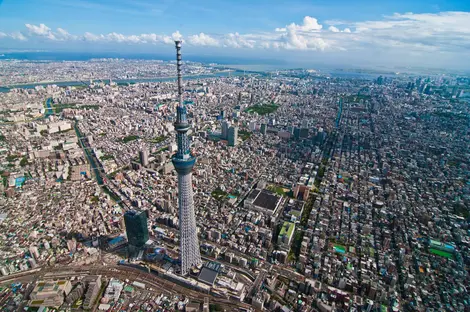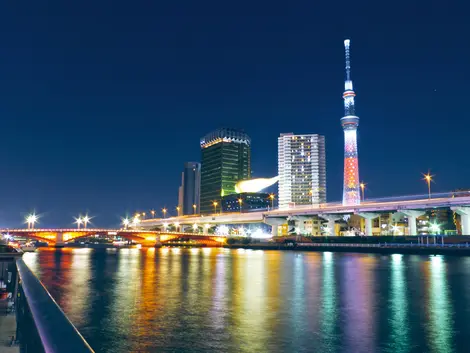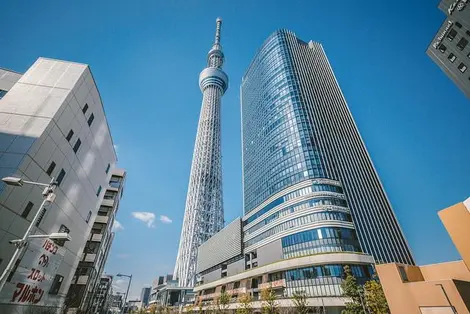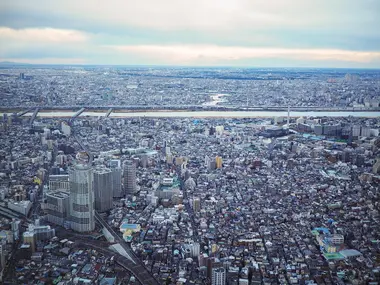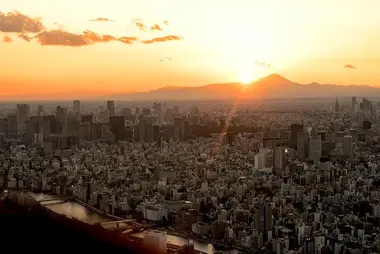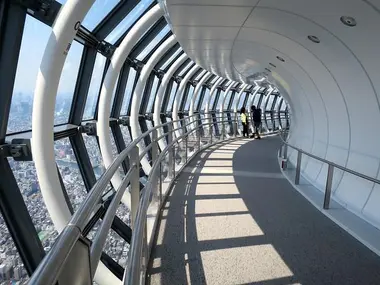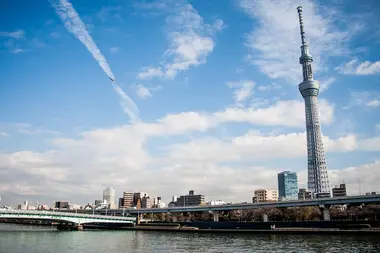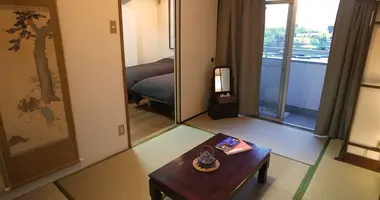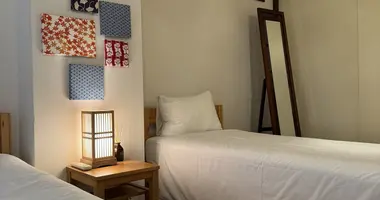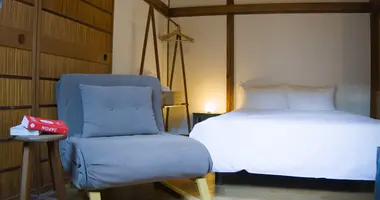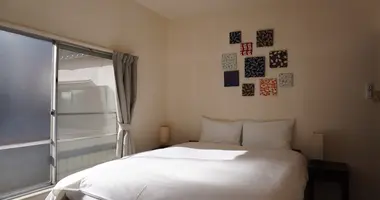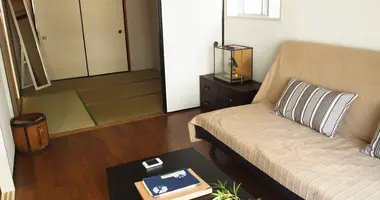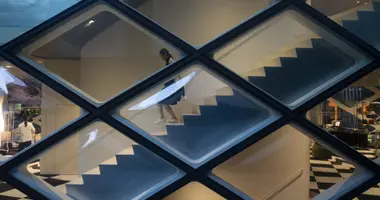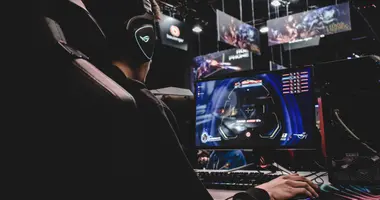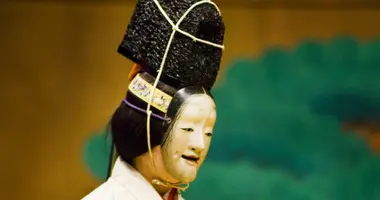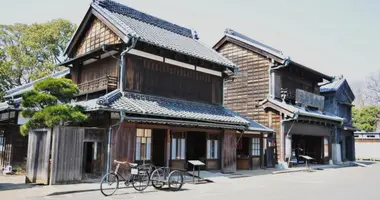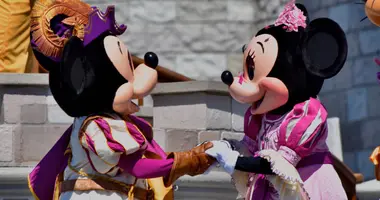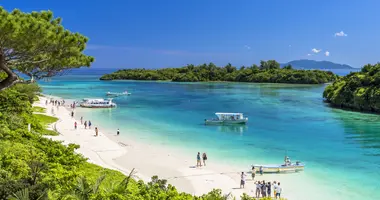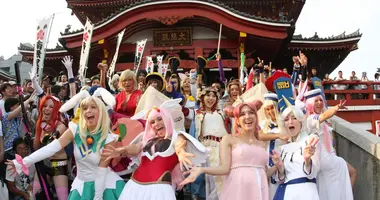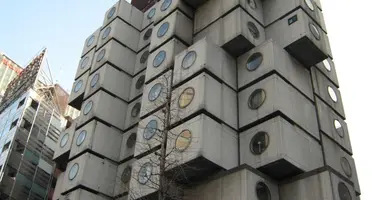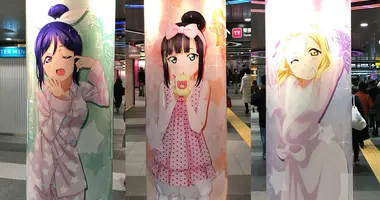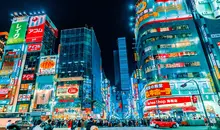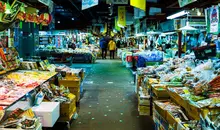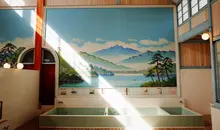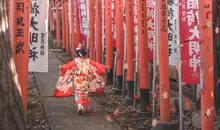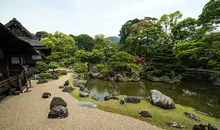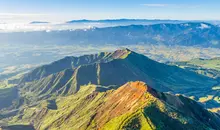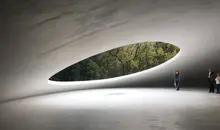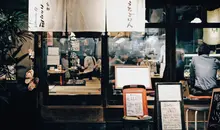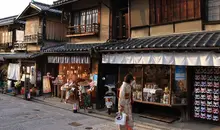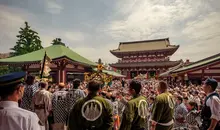Tokyo Skytree Tower
- Published on : 28/08/2019
- by : E.P. / J.R.
- Youtube
Stunning views from Japan's tallest tower
Tokyo Skytree, inaugurated in May 2012, is an imposing broadcasting tower located in Tokyo's Sumida district. Reaching a height of 634 meters, this figure was not chosen at random, as it can be pronounced "musashi" in Japanese, referring to the former province where the tower is erected. Now an essential symbol of modern Japan, it combines technical functionality and tourist appeal, with its observatories offering exceptional panoramic views. This architectural marvel was designed to withstand earthquakes thanks to cutting-edge Japanese technologies, making it the world's second-highest self-supporting structure after Burj Khalifa.
History and design of Tokyo Skytree
The Tokyo Skytree project began in December 2003, initiated by NHK and six commercial TV and radio channels who wanted to build a new broadcasting tower to improve digital terrestrial transmission. The Tokyo Tower, erected in 1958, had become inadequate, as transmissions were hampered by the many skyscrapers built nearby.
In March 2006, the Sumida district invited the Tôbu railroad company to join the project, choosing the site between the former Oshiage freight station and Narihira-bashi station (now renamed Tokyo Skytree station) as the site for construction. The borough's former mayor, Yamazaki Noboru, wanted to dispel the district's image of industrial greyness with this new, light-colored tower.
Construction work, managed by Tobu Tower Skytree, began on the Oshiage site on July 14, 2008. Initially planned to measure 610 meters, Tokyo Skytree finally reached 634 meters, symbolizing the province's former name "Musashi" (mu-6, sa-3, shi-4). At its inauguration on May 22, 2012, over 220,000 people flocked to the Skytree despite the rain, marking the start of a new era for this district of Tokyo.
Technical features and remarkable architecture
Tokyo Skytree's unique architecture combines modernity and Japanese tradition. Its structure rests on a triangular, tripod-shaped base that gradually rises to become cylindrical at a height of 350 metres. This singular design is inspired by the profiles of traditional Japanese swords and the curves of ancient temples, notably the structures of Hôryûji temple from the Nara period (710-794).
To ensure its resistance to earthquakes, engineers adopted the age-old technique of the "shinbashira", the central pillar of ancient Japanese five-storey pagodas. The center of the tower is occupied by a steel-reinforced concrete cylinder 375 meters high, 8 meters in diameter and weighing 11,000 tons. The special feature of this system is that only the lower third of the cylinder is fixed to the structure, while the upper two-thirds can oscillate freely, their movements being absorbed by hydraulic dampers.
During the devastating earthquake of March 11, 2011, while the tower was still under construction, this anti-seismic device proved its effectiveness: the structure was not affected, and a week later, the lightning conductor could be installed at the top of the tower. This technical feat demonstrates Japan's ability to combine technological innovation with traditional architectural wisdom.
As for its exterior appearance, the tower is painted in a color officially named "Skytree White", a traditional Japanese bluish white called "aijiro" (藍白). At night, it lights up in three color patterns that alternate daily: Iki ("chic"), Miyabi ("elegance") and Nobori ("vivacity"), creating a remarkable visual spectacle visible from many points around the city.
The observatories: a breathtaking view of Tokyo
The Tokyo Skytree has three observation platforms open to the public, each offering a unique experience. Tickets and elevators are sold on the 4th floor of the tower. The two main platforms are the "Tembo Deck" at 350 metres and the "Tembo Galleria" at 450 metres. A third, more recent platform, the "Skytree Terrace" on level 155, is unique in that it is open-air, with a guided tour.
The Tembo Deck, the first accessible observatory, extends over three levels (from 340 to 350 metres). After ascending in an elevator at the impressive speed of 600 meters per minute, visitors discover a 360° panoramic view of the city. At level 350, a glass floor allows visitors to admire the Skytree structure and the void beneath their feet, offering a unique vertiginous sensation. This deck also includes a café, restaurant, souvenir store and toilets.
For those wishing to climb even higher, the Tembo Galleria at 450 meters offers an even more impressive experience. It is reached by a second elevator from the Tembo Deck. Although the view is similar to that from the first observatory, the impression of floating above Tokyo is even more striking. On a clear day, you can see as far as Mount Fuji, standing majestically on the horizon.
Since July 1, 2016, virtual reality goggles have been installed in the galleries to enjoy the view under a blue sky, whatever the weather conditions. The view is particularly spectacular at sunset and at night, when the city lights up with a thousand lights, creating an urban panorama of incomparable beauty.
Tokyo Skytree Town and the Solamachi complex
At the foot of the Tokyo Skytree lies the Tokyo Skytree Town shopping complex, of which the "Solamachi" (meaning "city of sky") shopping center is the beating heart. This vast 230,000 m² shopping area brings together some 300 stores, restaurants and attractions, making this area much more than just a viewpoint over Tokyo.
Among the main attractions is the SumidaAquarium, particularly popular for its area dedicated to penguins and its unique display that allows you to observe the sea creatures up close. The "Tenku" planetarium, meanwhile, offers immersion in the starry heavens thanks to sophisticated audiovisual productions and reclining seats for optimum comfort.
Shopping enthusiasts will be delighted by the diversity of boutiques, including one of the largest, Donguri, the official Studio Ghibli merchandise store. Fans of Japanese animation and otakus will also appreciate the temporary exhibitions regularly organized on the theme of mangas such as Dragon Ball, One Piece or Attack of the Titans.
In winter, a large open-air skating rink, the "Tokyo Sky Tree Town Ice Skating Park", is set up on the fourth floor, open daily from 11am to 8pm (9pm on Fridays, Saturdays and Sundays). Prices are 2,000 yen for adults and 1,200 yen for children aged 12 and under.
When it comes to dining, the complex offers a multitude of options, from food courts to gourmet restaurants. The 6th and 7th floors are home to "Solamachi Dining", featuring local specialty restaurants from all over Japan, while the 30th and 31st floors offer the "Solamachi Dining SKYTREE VIEW", where you can enjoy a meal while admiring the tower from a height of around 150 meters.
Practical information for visiting the tower
To make the most of your visit to Tokyo Skytree, here's some essential practical information. The tower is open daily from 8 a.m. to 10 p.m. (last admission at 9 p.m.), but it's advisable to check times before your visit as they may vary according to special events.
Rates are structured according to different formulas:
- Tembo Deck 350 ticket: 2,100 yen (approx. €18) weekdays
- Combined ticket (floors 350 and 450): 3,100 yen (approx. 26€)
- Access to floor 450 from floor 350: 1,000 yen (approx. 8.50€)
- Terrace 155 ticket: 2,500 yen (approx. 21€)
Fast Skytree tickets are available from a special ticket office on the 4th floor, at the same price every day of the week:
- Tembo Deck 350 ticket: 3,200 yen (approx. €27)
- Combined ticket: 4,200 yen (approx. €35)
For full price details (including weekend and children's prices), visit the Prices page of the official website.
Please note that the Tokyo Skytree is very busy: you often have to be very patient to get on the elevators. To avoid long queues, we advise you to plan your visit early in the morning or in the evening, around 8pm. Unfortunately, it's not possible for foreign visitors to buy tickets online, as you'll need a Japanese bank card.
To get to Tokyo Skytree, you have several options:
- By subway: Asakusa line (exit A20) or Hanzomon line (exit Z14) to Oshiage station
- By train: Isesaki line to Tokyo Skytree station
- On foot: from theAsakusa district, it's about a 20-minute walk
The tower is also easily accessible from other tourist districts, such as Shinjuku or Shibuya, with journey times of around 30 to 40 minutes by subway.
Illuminations and special events
At night, the Tokyo Skytree is transformed into a dazzling light show that adds a magical dimension to Tokyo's urban landscape. Its illumination system uses energy-saving LEDs that allow the tower to dress up in different colors according to a well-defined program.
Each evening, the tower alternates between three lighting styles inspired by traditional Edo culture:
- Iki (blue): representing sophistication and urban chic
- Miyabi (purple): evoking the refined elegance of classical Japanese culture
- Nobori (orange): symbolizing liveliness and prosperity
In addition to these regular illuminations, the tower offers special lighting for special events and seasonal celebrations. For example, during the Christmas season, special illuminations in green (Champagne) and red (Bougie) are programmed according to a specific schedule.
Throughout the year, Tokyo Skytree hosts numerous temporary events to enrich the visitor experience. From January 25 to February 29, 2024, for example, the Tembo Deck was transformed into an open-air disco for the "Super SkyTree Disco" event, with a special bar open from 7pm to 10:30pm for DJ nights.
Other highlights included exhibitions dedicated to popular franchises such as Dragon Ball Super "Broly" (November 1, 2018 to January 7, 2019) or Final Fantasy VII Remake (February 6 to April 22, 2020), with attractions, limited-edition merchandise, original menus and themed decorations right down to the elevators.
Seasonal festivals are also enthusiastically celebrated: spring is marked by cherry blossom celebrations and the Koinobori festival, summer by spectacular fireworks displays, autumn by gastronomic festivals featuring seasonal dishes, and winter by even more impressive illuminations and holiday events.
To admire the illuminated tower from the outside, several vantage points are recommended, including theAsakusa Tourist and Cultural Center (Asakusa Bunka Kanko Center), Sumida Park (Sumida Koen) and the Jukken Bridge along the Sumida River.
Tokyo Skytree over the years: impact and ridership
Since its inauguration in 2012, Tokyo Skytree has enjoyed considerable success, even if attendance has fluctuated somewhat over the years. Tōbu's initial estimates predicted around 5.4 million visitors in the first year, then 25 million each subsequent year - a target that proved too ambitious.
The first year of operation saw 6.9 million visitors pass through the tower's gates, exceeding initial expectations. In subsequent years, however, visitor numbers stabilized at an average of 4.4 million per year. According to precise data, the 2013 fiscal year welcomed 6.19 million visitors (slightly below forecasts due to 40 days closed for bad weather), while in 2014, 5.94 million visitors were expected.
In November 2015, three and a half years after its opening (1,267 days to be precise), the Skytree celebrated its 20 millionth visitor - a Japanese woman from Gunma prefecture who received a large bouquet of flowers on the occasion. According to the tower's representatives, more than half the visitors at the time were foreign tourists, illustrating the ambition to make the Skytree a "new symbol of Japan".
However, according to the Yomiuri Shinbun, attendance has continued to gradually decline since 2013, reaching around 4.3 million visitors in 2017. To revive interest, at the end of October 2018, the managing company opened a third observatory lower down, at an altitude of 155 meters, with the distinctive feature of being in the open air.
More recently, on September 21, 2024, the tower passed the symbolic milestone of 50 million visitors after 4,506 days of operation (just over 12 years and 4 months). A small commemorative ceremony was held in the presence of the 50 millionth visitor, a family from Chiba prefecture.
The Tokyo Skytree's impact on the urban environment has been considerable. The project was part of a wider vision to transform the Sumida district into an attractive tourist area, capitalizing on its position between the popular districts of Asakusa and Kameido. Urban development continued long after the tower's completion, with the improvement of facilities along the Kitajukken River, the burying of power and telephone lines, and the opening of new cultural attractions such as the Hokusai Museum in Ryôgoku in 2016.
The Skytree's positive influence can also be seen in the increase in the resident population of Sumida district, even during the health crisis, as well as in the rise in property prices and the influx of high-income residents. This virtuous circle has led to an increase in the borough's budget thanks to higher tax revenues, enabling further urban improvements that continue to transform this once-industrial district into a top tourist destination.
To discover this architectural marvel for yourself, you can book your Tokyo Skytree tickets and explore other Tokyo Activities to complete your stay.
For more information, you can contact Tokyo Skytree on +81(0)36 658 8012 or visit their official website http://www.tokyo-skytree.jp/en/.
Book your ticket for the Tokyo Skytree
Address, timetable & access
Address
Phone
+81(0)36 658 8012Timetable
Open daily, 8am to 10pm.
Last admission at 9pm.Price
Tembo Deck and Tembo Galleria combined ticket: 3100 yen (26€) weekdays
Tembo Deck ticket only: 2100 yen (18€) weekdays
Combined ticket: 4200 yen (35€)Access
Oshiage (Skytree) station on the Asakusa line (exit A20) or Hanzomon line (exit Z14)
Tokyo Skytree station on the Isesaki lineWebsite
http://www.tokyo-skytree.jp/en/
